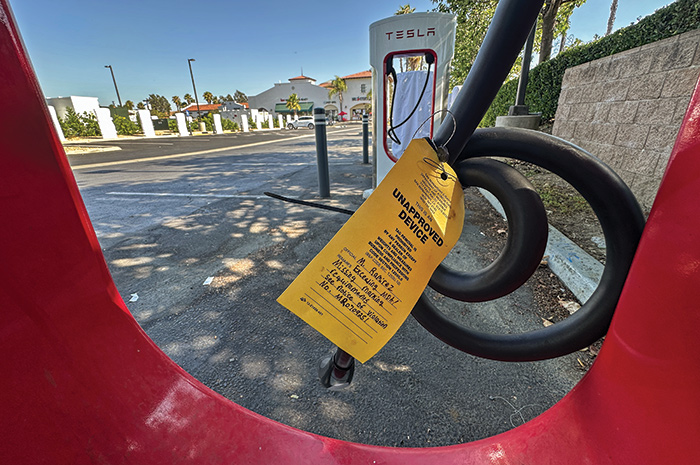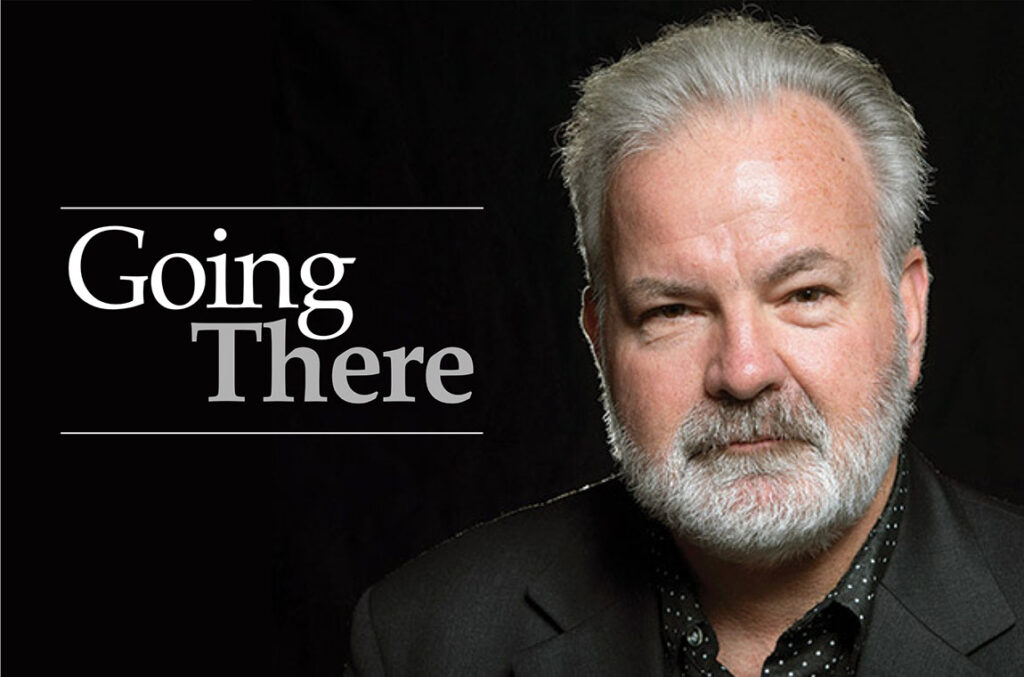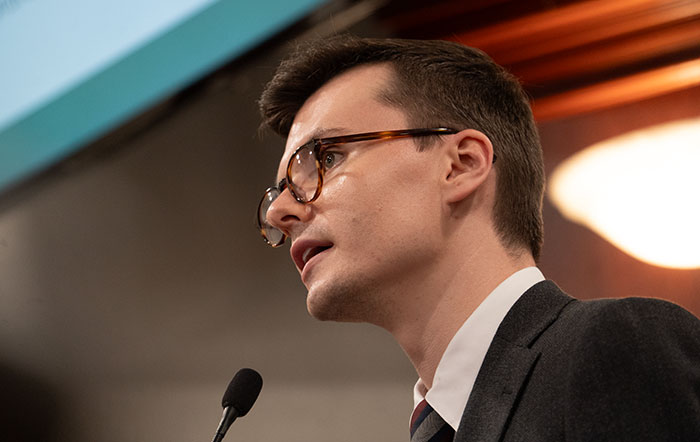Claremont history through the eyes of COURIER
publisher Martin Weinberger
Pioneering COURIER publisher Martin Weinberger died on July 5, 2011. The five-year anniversary of his death seemed like the perfect time to pore through back issues of the COURIER, tracing the publisher’s impact on Claremont’s venerable newspaper and on the community at large.
Mr. Weinberger was only 26 when he purchased the COURIER from Stanley Larson in 195
He changed the format of the newspaper from broadsheet to tabloid, because he felt the smaller size was easier to hold and leaf through. He added dramatic typography and placed a greater emphasis on photos—showcasing his personal passion for photojournalism and taking a page from photo-centric newsmagazines like Life and the Saturday Evening Post that were popular at the time.
Mr. Weinberger also put his stamp on the COURIER through his long-running “My Side of the Line” column.
Rereading his weekly observations, it becomes evident the late COURIER publisher had a healthy sense of humor, ranging from dry to satiric and from puckish to barbed.
His dry wit was in evidence during the early 2000s, when Snoop Dogg had a residence in the City of Trees. Mr. Weinberger, then in his 70s, relished reporting on the rapper’s doings in his “Back Page” account of town happenings. Per COURIER style, he always referred to Snoop as Mr. Dogg upon second reference.
Nothing was sacred
The publisher was known to employ a generous dose of self-deprecation.
An article that ran in October 1959, no doubt penned by Mr. Weinberger, noted he had been scheduled to speak at a workshop of the California Newspaper Publisher’s Association in Berkeley. His topic? “Untapped news sources.” When he arrived to the scene, he learned his talk had been scheduled for the previous Friday. “His news sources are still untapped,” the article quipped.
In a May 1969 “My Side of the Line,” Mr. Weinberger acknowledged he was not immune to moments of vanity.
He related a story under the sub-heading “Tall”: “A man called the COURIER recently and asked for Mr. Weinberger. He identified him as that ‘tall man in the office.’” The publisher asked readers to take note of the descriptor. The caller didn’t describe Mr. Weinberger as solid or husky or healthy, but tall. “I felt elegant all over my body,” he joked. “That man didn’t know it but he probably could have had a free subscription for the asking.”
The newspaperman also had a gift for satire.
It was evident in a March 1958 column where he shared some definitions pertaining to the political scene. “Politician: Description of the candidate from the other party. Ours is a statesman. Practical politician: One who can remove the bumper sticker of a losing candidate off his car without damaging the paint. Government: That institution of man which has the ability to creep, centralize itself, bury itself in red tape and prepare everything in triplicate.”
The pen is mightier than the sword
Mr. Weinberger wasn’t afraid to move from the general to the particular and skewer cringe-worthy behavior among local decision-makers.
In September of 1959, LA County Fair officials rejected the publisher’s request that a booth be set up at the fair for voter registration and to provide general governmental information. The officials claimed there was no room for the enterprise.
Mr. Weinberger, believing revenge was best served in print, proceeded to send up the decision in a Swiftian manner.
It was a good thing fair officials were alert enough to uncover his dastardly plot, he said, “For the real intention of the voter registration was to check on all the pigs, cows, chickens, horses and elephants at the fair so that an accurate measure of their political affiliations might be made.
“Can you imagine the unfavorable publicity,” Mr. Weinberger asked, “if an elephant had registered any way but Republican? And if a donkey had indicated any party preference other than Democrat? . . .Why, it would have been a terrible blow for the fair.”
Claremont’s July 1958 Independence Day celebration provided another chance for Mr. Weinberger to take a jab at the powers that be.
The Fourth of July committee had arranged for two US Army tanks to roll through city streets as part of the annual parade. Mr. Weinberger was a Korean War veteran, but he was also a dyed–in-the wool liberal. He may have objected to the tanks’ presence, and the implicit association of patriotism with military might, had the armored vehicles come and gone without a trace. They did not.
The sheer weight of the tanks left behind a dark and gritty imprint of their passage, as documented in a COURIER photograph. The caption read, “Two tanks plus newly-paved streets add up to this—at least in Claremont. By Monday morning the city manager was figuring out ways and means to repair and celebration officials wondered just how heavy Uncle Sam’s tanks can be.”
In the same issue, Mr. Weinberger employed a Joseph Heller-like touch of irony in his My Side of the Line. He assured readers there would be no repeat of the debacle the following year: “Only missiles and missile launchers will be allowed in the parade. This tank stuff is old business from World War II, anyway.”
The US military played a part in another column following a June 1969 council meeting where a group of residents asked to enter an anti-Vietnam War float in the Fourth of July parade.
Mr. Weinberger took a moment to applaud the city council, which granted the request after long and heated deliberation.
“It is a sensitive matter indeed to talk about freedom of expression when American young men are dying thousands of miles away; the implication is that any criticism of the strategy, or the aims of the military, or our purpose, is unpatriotic and disloyal, and therefore hurting our military effort.
“I do not agree with that,” he continued. “Our purpose is not to imitate Hanoi in seeking to defeat North Vietnam’s military. Our purpose is to preserve the freedoms—of speech, press, assembly and public expression, in particular—which we consider to be the very basis of our democratic power.”
What comes around goes around
Mr. Weinberger was prescient as well as droll as he touched on all manner of topics, from parks to bond measures to the condition of roads. Many echo today’s community concerns.
Much like the community now, he was concerned about the appearance of Foothills Boulevard.
In a November 1963 column, Mr. Weinberger lauded the city for beautifying Foothill: “Another attractive addition to the Foothill area has been the planting of grass on center strip malls. Foothill Boulevard, as it travels through Claremont, is an oasis compared to the same street under another name journeying through Glendora, Azusa and Duarte to the west of us.”
Fast forward to summer 2016. The oasis has dried up a bit now as the city, prompted by the ongoing drought, has pulled up the grass on Foothill Boulevard medians. The Eucalyptus trees are also looking a bit dry in the summer heat. Residents can rest assured, however. There’s a drip system lurking below the mulch, according to Interim Community Services Director Dave Roger. And the Foothill Boulevard Master Plan aims to revive Claremont’s somewhat arid strip of Foothill, including public art and drought-tolerant landscaping.
If Mr. Weinberger were around today, there’s no doubt he would be keeping an eager eye on the renovation of Foothill Boulevard.
Supporting infrastructure, education and culture
During a special election held in February of 1969, Claremont voters rejected no less than four bond measures, totaling $4,604,000.
The measures were part of an ambitious plan to transform the city. The largest of these called for $2,630,000 in civic improvements, including a new police station, city hall and fire department and the acquisition of land for city yards and a post office. Another $700,000 would fund construction of a new library, while a third $975,000 bond measure was for park development and acquisition. A fourth bond measure, with a price-tag of $300,000, would have funded construction of a center for performing and creative arts and development of an art gallery, possibly in the city hall facility.
Mr. Weinberger endorsed all four measures in advance of the vote, calling them “reasonable, practical and within the community’s pocketbook potential.” He was likely disappointed when Claremonters rejected the bond measures wholesale, but he didn’t take them to task. Instead, he gently cautioned the community against thinking only in terms of dollars and cents while in the voting booth.
“It seems to me that we have become preoccupied with the cost of things as far as government is concerned,” he wrote in March 1969. “So preoccupied that we exclude human values and the consideration of the welfare of human beings.
Mr. Weinberger posited that the bond measures, had they passed, would have yielded intangible but salutary results.
“Has anyone asked if the new fire facilities are needed to save someone’s life?” he posed. “What if the crafts center produced a great puppeteer? How could we ever measure his value to society? What if the library’s added volumes and attractiveness would enable just ONE child to go to college that otherwise would not have cut the mustard? How can we measure the value of education in society?”
Looking to 2016, Claremont homeowners will be asked to pay for significant infrastructure updates in the coming months.
In November, residents will vote on a $58 million school facilities bond measure to pay for upgrades throughout the Claremont Unified School District. And as soon as Claremonters have discarded their “I voted” stickers, the city will begin looking for the perfect time to place a $25 million police facilities bond on the ballot.
We have no way of knowing if Mr. Weinberger would have endorsed either bond measures. What is certain is he would have encouraged residents to ask some questions about the human benefits of improved conditions for our police and students.
Claremont’s unique identity, town-gown connection
Not long after acquiring Claremont’s community newspaper, Mr. Weinberger was asked what he felt would be the city’s greatest problem in the next 25 years. He named two.
“First, the ever-present danger that with a rapid influx of population from other areas, Claremonters of the future might lose a strong sense of community identity.”
This question resonates with today’s Claremonters, who in 2016 seek to retain their sense of identity in the face of population growth fostered by new development and an explosion of visitors, drawn by the recent business boom.
Can residents enjoy the tax money from new development and the convenience of a movie theater and bustling nightlife close to home, without turning into something else—say Pasadena? And more importanly, can they find a parking spot?
Mr. Weinberger determined that while the topic of community identity was certain to remain a pressing question, he was optimistic.
“Judging by the performance of newcomers in the past two or three years, the sense of community identity arrives quickly and in considerable strength.”
The second question was more of a poser. The Colleges, Mr. Weinberger noted, have played a major role in the development of Claremont. While most people who move to the city come because of the college-town atmosphere, few of them any longer actually work in any capacity at the Colleges.
“The lives of most of us are conducted almost entirely without contact with the cultural life of the schools,” Mr. Weinberger wrote before wondering how the Colleges’ “intellectual power-gathering” could best be “released from the ivory tower and turned toward community and individual betterment.”
“Claremont has that problem now—and will continue to have it in the immediate future,” he continued. “While I am impressed by the grandeur of $12 million building programs for a campus, I do not want to see those buildings become part of an isolated city within a city. Our cultural interchange should be something more than buying a ticket to watch a guest pianist perform at Bridges.”
The state of Claremont’s town-gown relations is also a hot topic in 2016, as evinced by the dust-up over the Pomona College Museum of Art.
Opponents say the college’s intent to build a museum on the west side of College Avenue represents “college creep.” Having an institutional building located there, they argue, changes the traditional character of a longstanding residential area.
Proponents of the plan say having a multi-million-dollar museum located on the edge of the Village will be a boon, drawing visitors willing to spend money at local establishments and giving residents free exposure to art and culture.
Considering the city council has approved the Pomona College Master Plan, it appears the college is well on its way to building the new museum. What would Mr. Weinberger have said about the project? One can only speculate.
No one could say for sure if he would be impressed by the grandeur of a multi-million dollar museum, but it’s certain he would have cherished hopes that the facility would incorporate amenities and events providing a warm and lasting welcome to the city’s residents.
Mr. Weinberger was seeking to do more than fill pages when he wrote his column. He was aiming for the qualities that, according to an October 1966 “My Side of the Line,” he considered paramount in a community paper.
“The newspaper should inform, it should entertain and it should excite interest. It should treat itself and readers with a light touch on many occasions,” he said. “And it should exert a high degree of leadership.”
Mission accomplished, Mr. Weinberger.
—Sarah Torribio
storribio@claraemont-courier.com








0 Comments